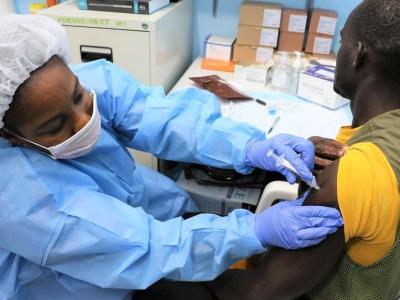Sep 24, 2008 (CIDRAP News) – Public health and medical leaders predicted today that this year's influenza vaccine will match up well with circulating flu viruses—unlike last year's vaccine—and that plenty of doses will be available.
"We are optimistic that this year's vaccine will be on target in protecting against the flu," said Dr. Daniel B. Jernigan of the Centers for Disease Control and Prevention (CDC), in a news release from the National Foundation for Infectious Diseases (NFID).
"Last year at this time we had an indication that the vaccine might not be as effective," Jernigan said at a press conference held today to promote flu immunization as flu season approaches. "There is no such indication this time."
CDC Director Julie Gerberding added that, on the basis of flu strains circulating in the southern hemisphere, "Right now we're at a point where we feel very confident."
Two of the three components in last year's vaccine—A/H3N2 and B—didn't match well with the circulating flu strains. A preliminary study from Wisconsin showed that the H3N2 component provided 58% protection against circulating H3N2 viruses, but the B component offered no protection.
Vaccine abundance
At the news briefing, officials from the CDC and several medical societies also predicted that plenty of vaccine will be available this season.
"Vaccine is out there in abundance," said William Schaffner, MD, president-elect of the NFID and chairman of the Department of Preventive Medicine at the Vanderbilt University School of Medicine. "We should continue to vaccinate through the fall and into winter and into the early part of next year."
A newsletter from the National Influenza Vaccine Summit, a coalition of numerous medical and health organizations, said last week that about 148 million doses, a record number, is expected to be available this season in the United States. About 35 million doses had been distributed as of Sep 5, the coalition said.
Last spring, the CDC recommended for the first time that school-age children, from 5 through 18, should receive flu immunizations, which added about 30 million children to the groups included in vaccination recommendations. (Children from 6 through 59 months old were included in earlier recommendations.) In all, 261 million Americans are targeted in the CDC recommendations, the NFID said.
The reason for immunizing school-age children is that they have higher flu rates than most groups and the virus spreads easily in schools, said Dr. Renee Jenkins, president of the American Academy of Pediatrics. "And reducing the rate in children reduces the rate in the community at large," she added.
Officials said 86 children died of flu in the 2007-08 season.
Under-immunized groups
Immunization coverage varies widely among the different flu-shot target groups, officials said today. The NFID said immunization rates last year were 66.7% for people 65 and older—well below federal targets—and 36.2% for those between 50 and 64. CDC data show that only 21.3% of children aged 6 through 23 months were fully vaccinated in the 2006-07 season, the NFID reported.
A recent NFID consumer survey of 2,029 adults pointed up the need for healthcare providers to promote flu vaccination, officials said. Seventy percent said they would be very likely to get vaccinated if their provider recommended it. But nearly 4 in 10 respondents overall, and nearly 1 in 5 elderly people, reported they had never discussed flu vaccination with their provider. Of those who had talked about the subject, half said they had raised it themselves.
More than 30% of Americans who receive Medicare do not receive flu shots, said Kerry Weems, acting director of the Center for Medicare and Medicaid Services, in the NFID release. Medicare covers both flu and pneumococcal vaccinations for all beneficiaries. Officials also urged all Americans 65 and older to get the pneumococcal vaccine, which guards against infections that cause pneumonia, meningitis, and sepsis.
Coverage in healthcare workers
Officials at the briefing also stressed the need to increase flu immunization coverage among healthcare workers, only 42% of whom were vaccinated in 2006.
Gerberding expressed a personal view that it is "unconscionable" for a healthcare worker to avoid flu immunization unless he or she has a medical contraindication.
"I would encourage healthcare facilities to measure their levels of vaccination and report them," and patients should ask about the rates, she said.
When a reporter asked if any healthcare facilities are requiring employees to be vaccinated, Schaffner said, "There are individual facilities that are moving in that direction. We're hoping that they will document their activities and publish that so we can all benefit from those things."
Another question was whether experts have identified particular groups of people who are less likely to get flu shots. Schaffner replied, "It's quite clear that African-Americans and Hispanics and others don't avail themselves as of immunization as often as Caucasians do."
In response to another question, Gerberding declined to predict how bad the upcoming flu season will be. "As far as prognostication, I've learned the hard way never to predict anything about influenza," she said.
Schaffner offered a different answer: "I'll predict something: There will be influenza, it will come, we'll have an outbreak, there will be people ill, some will be hospitalized, and some will die."
See also:
Sep 19 National Vaccine Summit newsletter
http://www.preventinfluenza.org/summit_news_91908.pdf


















